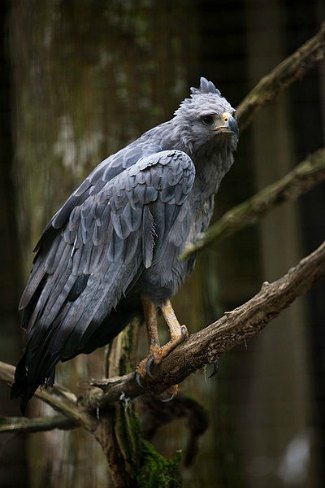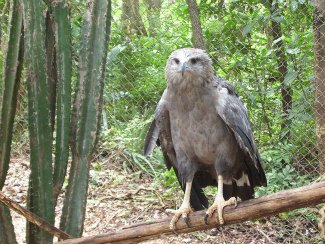Crowned Solitary Eagle - Harpyhaliaetus coronatus
By Nori Almeida, CC-BY-2.0, via Wikimedia Commons
Family: Accipitridae
Genus: Harpyhaliaetus
Species: H. coronatus
Crowned Solitary Eagles are endangered, semi-crepuscular raptors that live in South America. They face several threats, including habitat destruction and direct persecution.
Physical Description:
Crowned Solitary Eagles are all gray, except for a black tail that has a single white band and a white tip. The crest is bushy and prominent. The wings are long and broad, and the tail is short. The legs and cere are yellow.
Juveniles are brown from above with a buff head and underparts, and brown streaks on breast. The lower belly and legs are heavily barred, and the tail has a clear white subterminal band.
Their call is a long, high-pitched whistle, which can be heard from a distance of 2 kilometers. Listen to a Crowned Solitary Eagle.
Size:
Length: 75-85 cm
Weight: 2.9 kg
Habitat and Distribution:
Crowned Solitary Eagles inhabit semi-open dry country, such as savanna, grassland, sparse woodland, and bushy steppes. They have also been found in hilly areas, gallery forest, and cattle ranches, 0-1,200 meters above sea level. They are semi-crepuscular—crepuscular animals are active during dawn and dusk.
They live in Brazil, Bolivia, Paraguay, and Argentina, from 7°S to 28°S. They used to occur in Uruguay, but have presumably been driven out.
Diet and Hunting:
Their diet consists of birds, mammals (in particular skunks and armadillos), reptiles, carrion, and fish.
They probably still-hunt from a perch.
Reproduction:
A large platform nest 1.2 m wide and 30 cm deep is built in a tree or a ravine. A single white egg is laid and incubated by the female for 39-45 days.
Conservation:
Crowned Solitary Eagles are listed as Endangered by BirdLife International since they have a very small and declining population of 250-999 individuals. They face severe threats, since their habitats are being destroyed by agriculture, cattle ranching, invasive grasses, afforestation, pesticides, annual burning, and colonization, and the eagles are shot and deliberately disturbed.
Taxonomy:
Harpyhaliaetus coronatus was thought to be closely related to harpy eagles, but molecular studies showed that H. coronatus is closer to genus Buteogallus, in particular B. urubitinga (Great Black-Hawk). It forms a clade with B. meridionalis (Savanna Hawk), B. urubitinga, L. lacernulatus (White-Necked Hawk), Leucopternis plumbeus (Plumbeous Hawk), and L. schistacea (Slate-Colored Hawk).
Other Names:
Crowned Eagle, Harpyjovec korunkatý (Czech), Toppet Eremitørn (Danish), Kransarend (Dutch), Hall-hiidviu (Estonian), Kruunuerakkohaukka (Finnish), Buse couronnée (French), Zaunadler (German), Aquila solitaria coronata (Italian), Kammurinosuri (Japanese), Toppvåk (Norwegian), Harpijnik szary (Polish), Aguila coronada (Spanish), Kroneremitörn (Swedish).
Video of Crowned Solitary Eagles:
References:
http://avibase.bsc-eoc.org/species.jsp?avibaseid=ABDAC20ADB4AD0B5
BirdLife International (2011) Species factsheet: Harpyhaliaetus coronatus. Downloaded from http://www.birdlife.org on
21/11/2011.
Global Raptor Information Network. 2011. Species account: Crowned Solitary Eagle Harpyhaliaetus coronatus. Downloaded from
http://www.globalraptors.org on 21 Nov. 2011
Ferguson-Lees, James, and Christie, David A. Raptors of the World. Houghton Mifflin Company, 2001.

